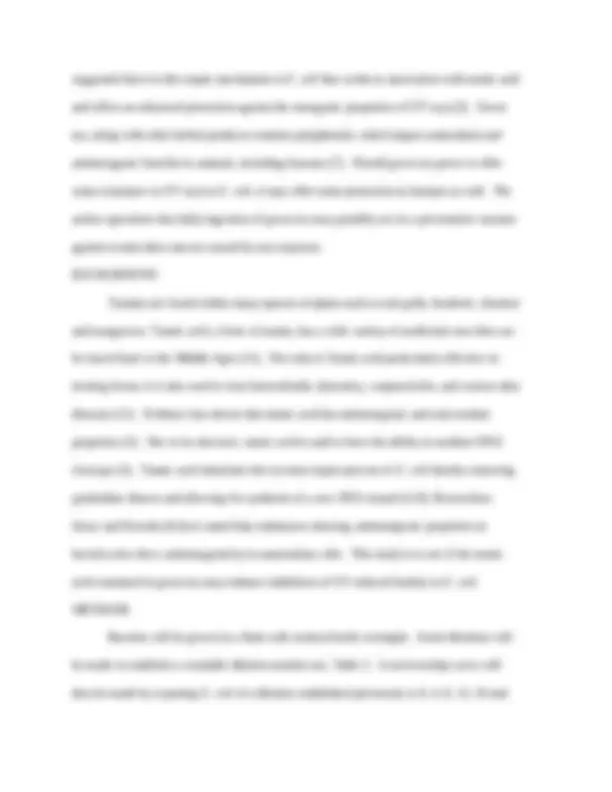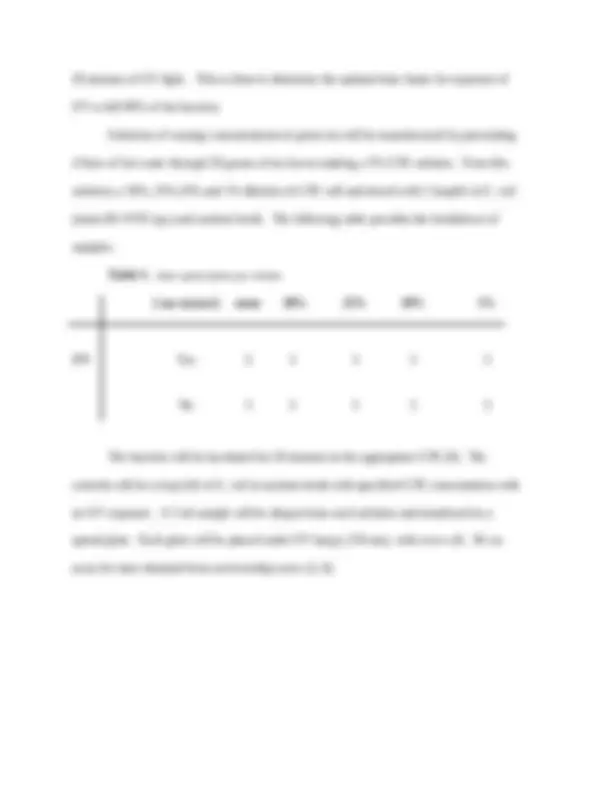






Study with the several resources on Docsity

Earn points by helping other students or get them with a premium plan


Prepare for your exams
Study with the several resources on Docsity

Earn points to download
Earn points by helping other students or get them with a premium plan
Community
Ask the community for help and clear up your study doubts
Discover the best universities in your country according to Docsity users
Free resources
Download our free guides on studying techniques, anxiety management strategies, and thesis advice from Docsity tutors
An undergraduate student's project proposal to determine if green tea extract increases the survival rates of e. Coli bacteria when exposed to ultraviolet (uv) radiation. The study involves establishing a countable dilution of bacteria, determining the optimal exposure time to uv light to kill 90% of the bacteria, and incubating the bacteria in nutrient broth with varying concentrations of green tea extract. The research is based on the hypothesis that green tea extract may offer protection against the mutagenic properties of uv rays due to its antioxidant and antimutagenic properties.
Typology: Study Guides, Projects, Research
1 / 8

This page cannot be seen from the preview
Don't miss anything!





Effects of Green Tea On E. coli Exposed To UV Light Rebecca Gurba Undergraduate Student at Wofford College Proposed Budget: $ 3rd Revision (March 3, 2002) PROJECT SUMMARY
The question being addressed is whether green tea extract increases survival of Escherichia coli exposed to ultraviolet radiation (UV rays). Before the experiment is conducted, two pieces of information should be obtained. A dilution yielding a countable number of bacteria should be established. With that dilution number, a survivorship curve experiment must be conducted to establish the optimal exposure time of bacteria to UV light to kill off 90%. An aqueous solution of green tea extract (GTE) will be created as well. The GTE of varying dilutions will be mixed with E. coli in a nutrient broth (the experimental group). The bacteria will incubate in their respective GTE nutrient broth solutions allowing for uptake of green tea extract. Small quantities will be pipetted out onto plates and exposed to UV light. The bacteria will then be incubated and their colonies will be counted and compared with controls. It is anticipated that there will be a correlation between the number of surviving bacteria after UV exposure, and the concentration of green tea extract the bacteria were incubated. JUSTIFICATION The purpose of the experiment is to determine whether green tea extract increases survival rates in E. coli bacteria exposed to UV light. UV rays cause the formation of cross- linking of adjacent pyrimidine bases thereby forming pyrimadine dimers (1). These pyrimadine dimers are detrimental to the cell because they halt transcription that will inevitably lead to cell death (10). Some strains of E. coli have DNA repair enzymes which function in the reversal of dimer formations (1). The strain chosen for the experiment (B/r WP2 trp-) is one such strain. The DNA of this bacteria strain contains a DNA excise repair mechanism, similar to that of human DNA, only involving fewer genes (2). It has been
20 minutes of UV light. This is done to determine the optimal time frame for exposure of UV to kill 90% of the bacteria. Solutions of varying concentrations of green tea will be manufactured by percolating 4 liters of hot water through 20 grams of tea leaves making a 5% GTE solution. From this solution; a 50%, 25%,10% and 1% dilution of GTE will and mixed with 1 loopful of E. coli (strain B/r WP2 trp-) and nutrient broth. The following table provides the breakdown of samples: Table 1: three speard plates per column [ tea extract] none 50% 25% 10% 1% UV Yes 3 3 3 3 3 No 3 3 3 3 3 The bacteria will be incubated for 20 minutes in the appropriate GTE (9). The controls will be a loop full of E. coli in nutrient broth with specified GTE concentration with no UV exposure. A 5 ml sample will be aliquot from each solution and transferred to a spread plate. Each plate will be placed under UV lamp ( 254 nm), with cover off, 30 cm away for time obtained from survivorship curve (2, 8).
Table 2: the procedure for serial dilution After all samples are transferred to nutrient agar plate, they will be incubated for 24 hours in 32 degree Celsius (9). Colonies per ml of sample will then be calculated by using the formula: number of colonies on plate * reciprocal of dilution of sample = number of bacteria / ml (9). COMPLICATIONS A major complication in this study would be the complete annihilation of the bacteria after being exposed to the UV rays. The reverse could happen where bacteria were unaffected by the UV light. Another problem would be if the amount of tannic acid in green tea were not enough to make any difference in the bacteria surviving. Green Tea extract may also work to inhibit the growth of E. coli , giving falsely negative results. GOALS The goals of this experiment are to see a clear difference in the amount of colonies that survived the UV rays that were also grown with the green tea extractions, versus the